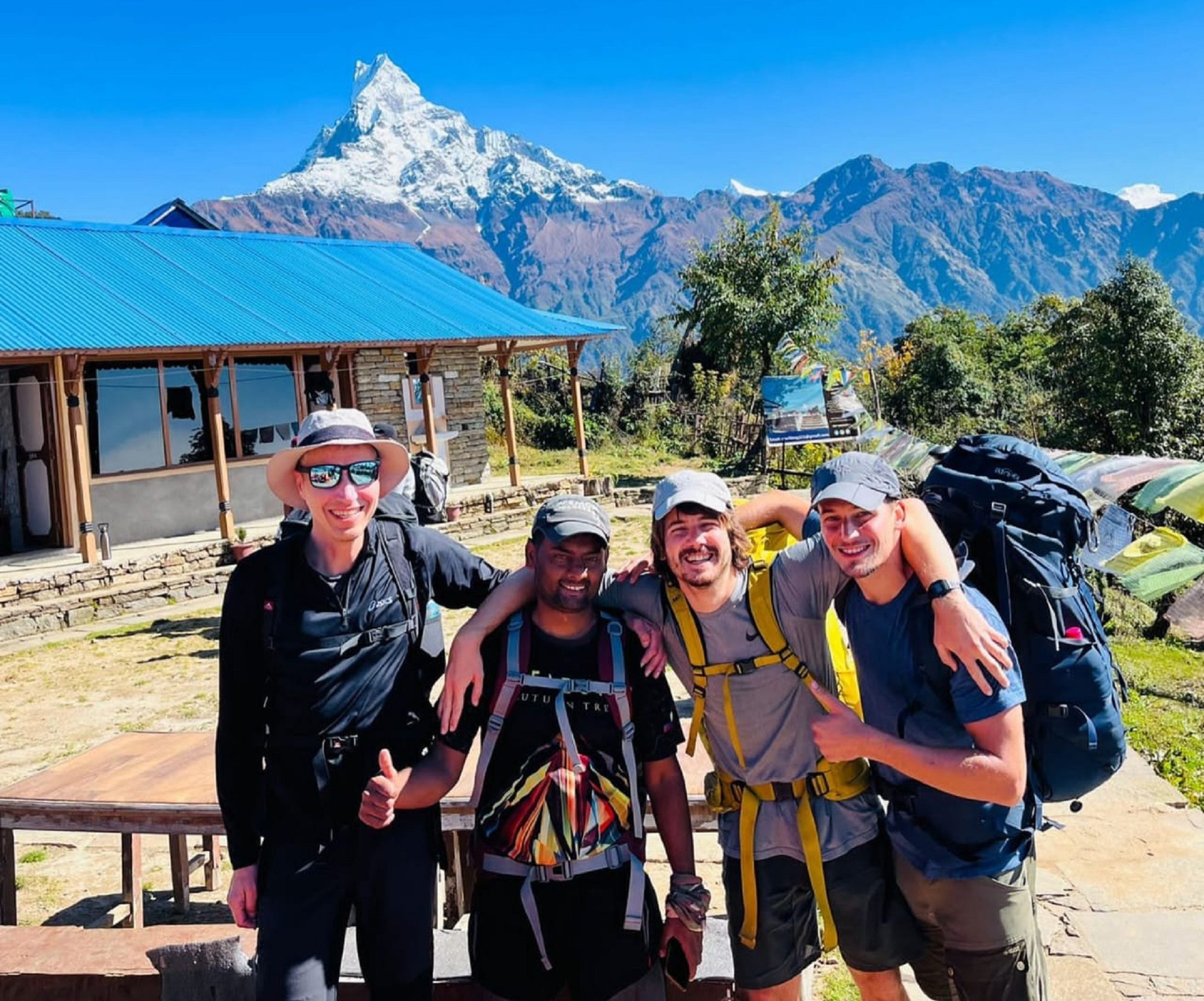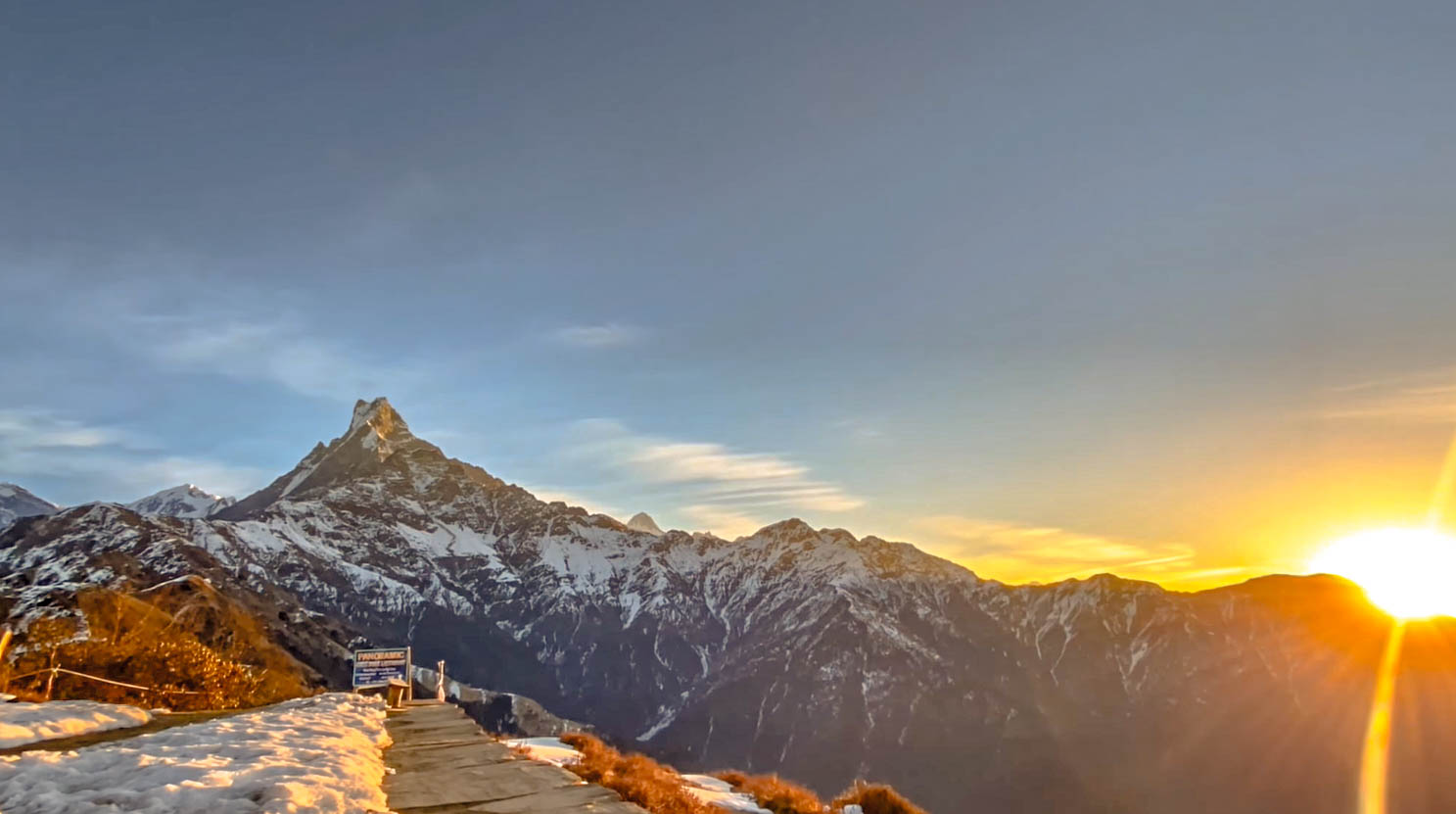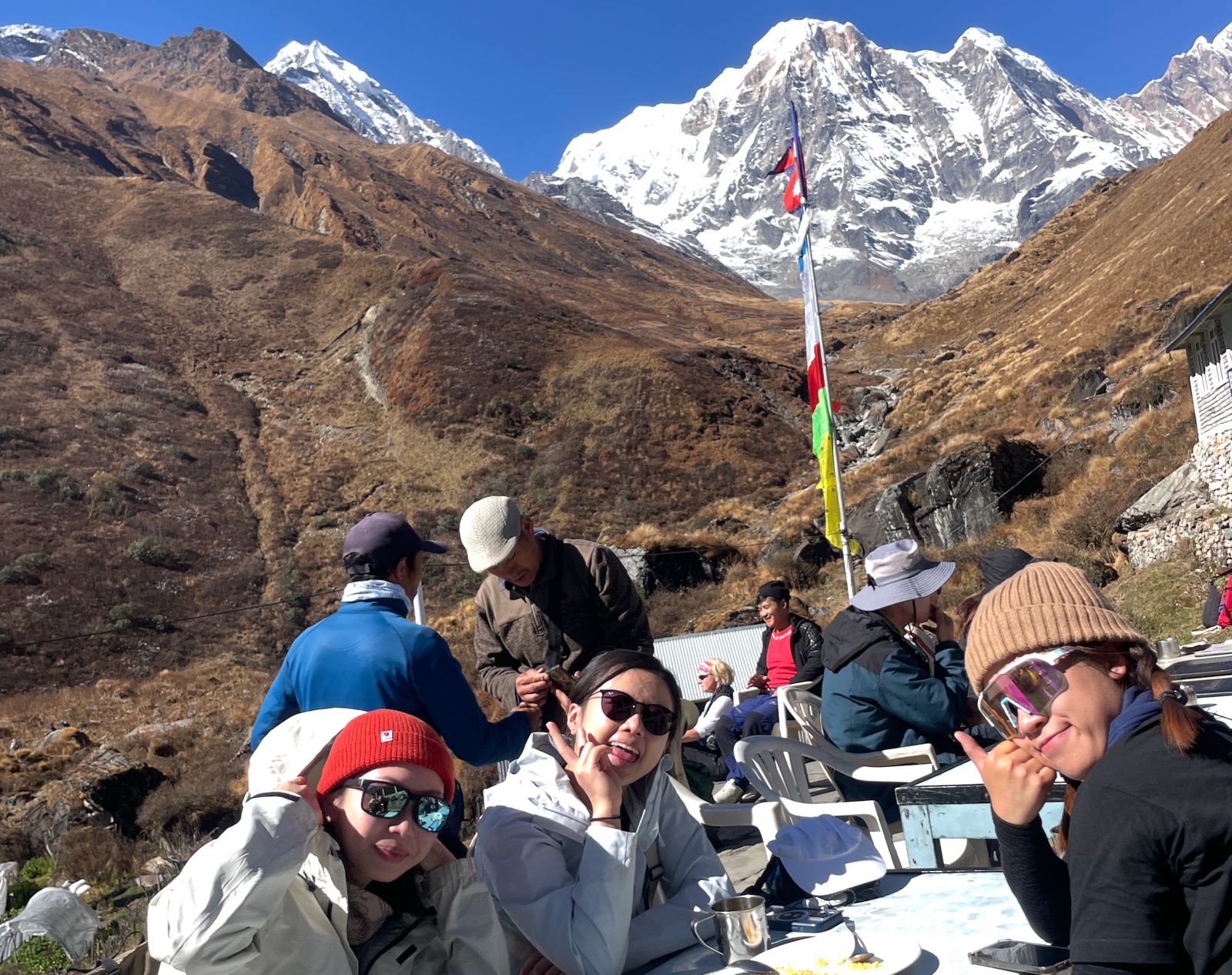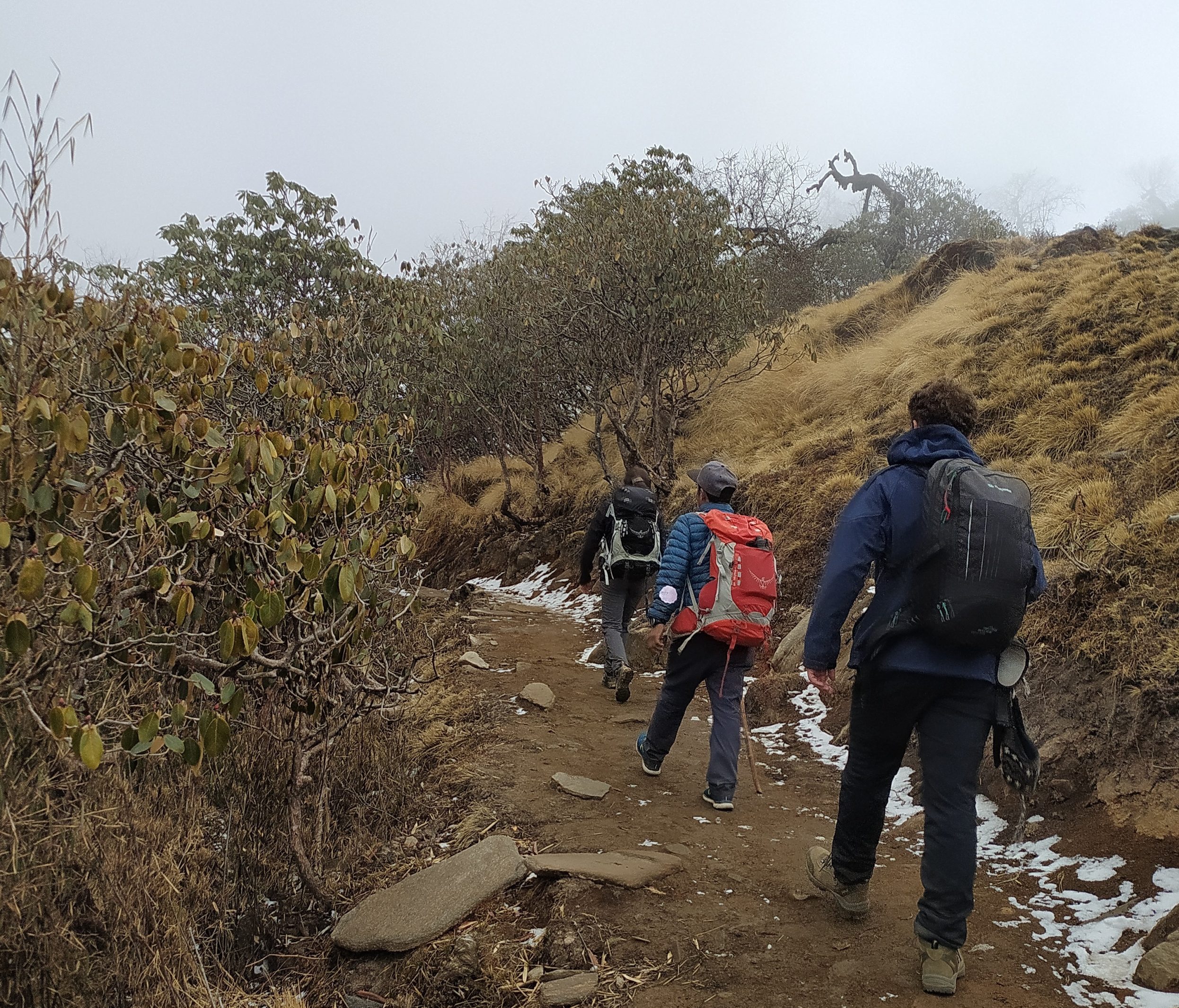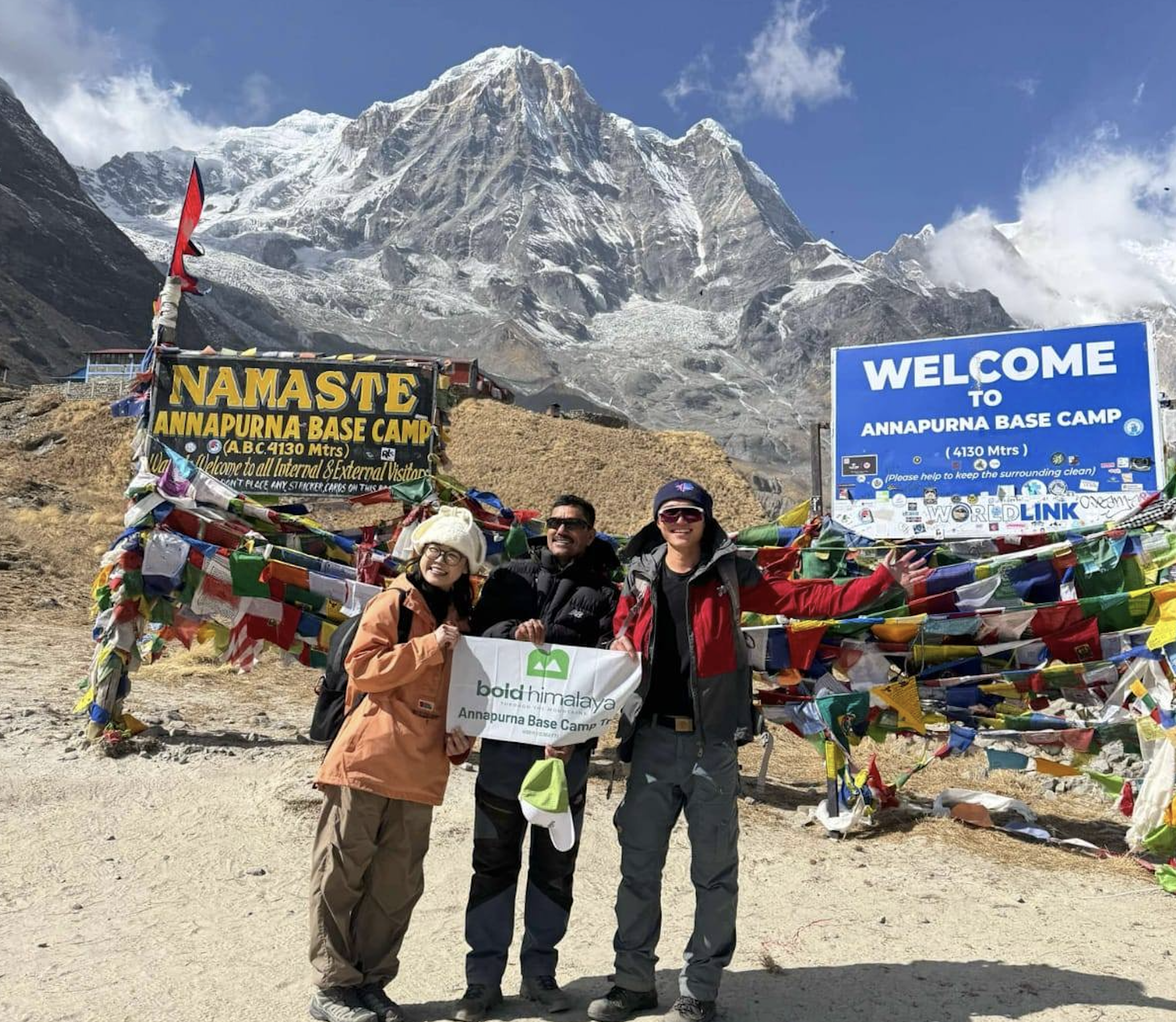Annapurna and Mardi Himal Base Camp Trek
Detailed Itinerary
Your Journey, Step by Step
Inclusions
What’s Covered in Your Adventure
- All ground transportation (including airport pick up/drop) by private tourist vehicles
- Three-star category hotel in the city(Pokhara, Kathmandu) in twin sharing bed with breakfast basis & standard trekking lodge in trekking route.
- Whole accommodations during trips
- Some necessary equivalents sleeping bag & Down jacket (if you need, return after trek)
- Full meals during trekking as mentioned in the itinerary (Breakfast, Lunch, Dinner )
- First aid medicine item
- Annapurna Conservation Area Trekking permit & TIMS card (Trekking Information Management System)
- Necessary staff, guide their salary, accommodation, meals and their insurance, professional guide
- One special cultural show and farewell dinner program
- 1 Duffle Bag, 1 T-shirt, and Trip certificate
- Our government/Local taxes and official expenses
- Extra Lunch & Dinner in Kathmandu & Pokhara
- Dessert & bar bills
- Your international air ticket & travel insurance
- Tips for the trekking crew members
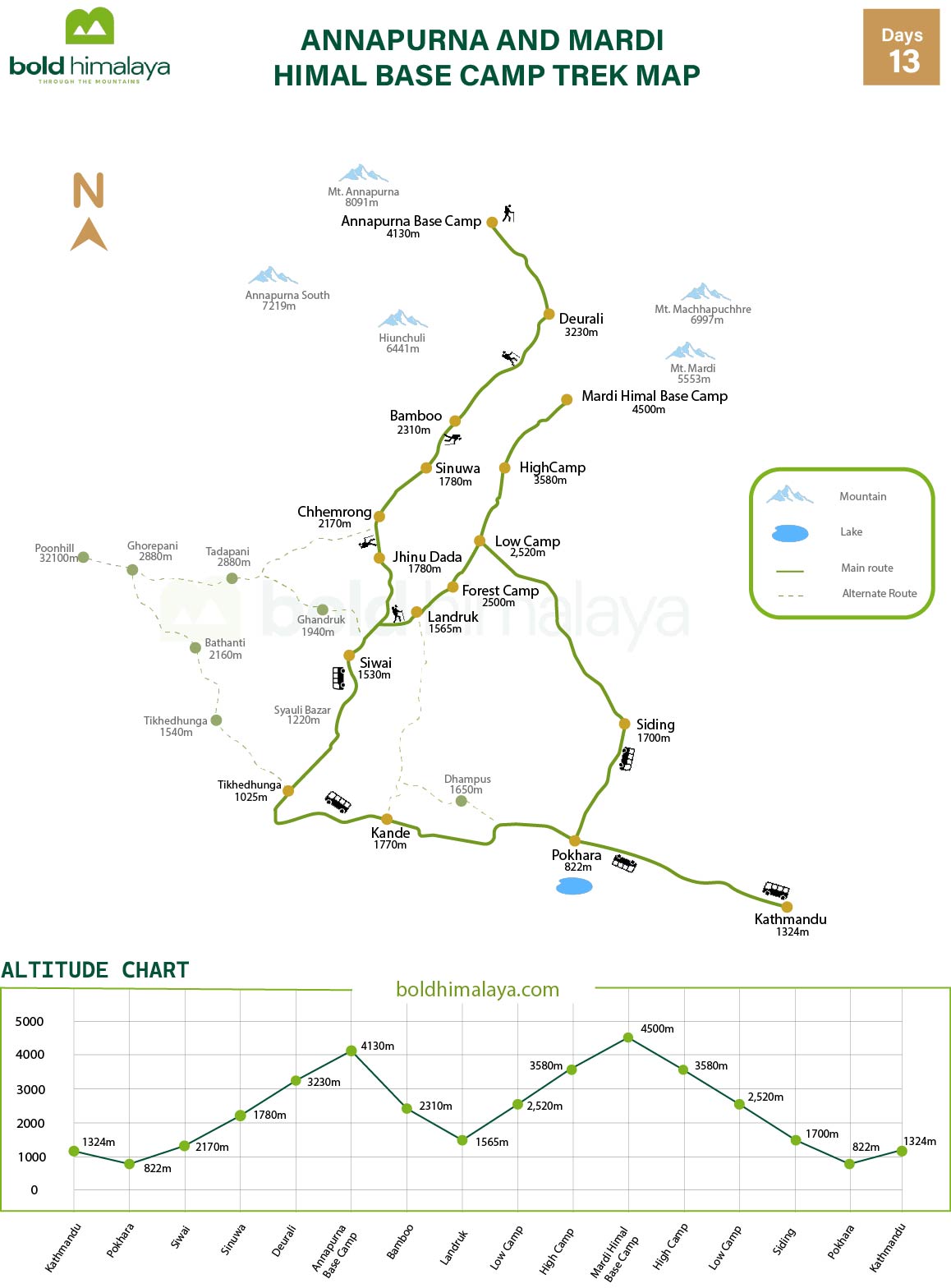
Good to Know
Reading this information will help you prepare better and enjoy a smoother trekking experience.
Food and Accommodation
Both the Annapurna Base Camp trek and the Mardi Himal Base Camp trek provide good, well-managed lodges with good accommodation along the trek. Basic teahouses provide basic dal bhat (lentils and rice) that provides the much-needed energy for the trek. Foreign food items such as noodles, pasta, fried rice, momos, and pancakes are available. Vegetarian and non-vegetarian dishes with fresh, locally grown vegetables are a common feature in all the lodges. Clhostel beds and blankets, shared latrines, and dining halls with a heater facility. Some of the high-altitude mountain lodges lack good basic facilities, but they provide hot meals and a warm night’s sleep.
Documents Required
Documents and permits required for the trek:
- TIMS Card (Trekkers Information Management System) – Mandatory for all trekkers
- Annapurna Conservation Area Permit (ACAP) – Both treks
- Valid Passport – Valid for at least 6 months beyond the travel date
- Nepal Visa – Most countries’ tourist visa
- Travel Insurance Certificate – For high-altitude trek
- Emergency Contact Details – Foreign phone number and local phone number
- Medical Certificate – High-altitude trekking medical fitness certificate
- Passport Photos – 4-6 photocopies for permits and documents
All Season Packing List
-
Spring/Summer (March-September)
- Hiking boots and sandals
- Quick-drying shorts and trekking trousers
- Warming tops and T-shirts
- Light fleece jacket and rain jacket
- Waterproof rain trousers and a poncho
- Warm beanie and sun hat
- Sun sunglasses and sun cream (SPF 50+)
- Light sleeping bag and liner
-
Autumn/Winter (October-February)
- Insulated hill walking boots and warm socks
- Thermal base layers and thermal underwear
- Warm fleece and a heavy down jacket
- Waterproof shell trousers and jacket
- Warm walking trousers and thermal tights
- Thick gloves and warm headgear
- Buff or neck warmer
- Four-season sleeping bag rated -15°C
-
Items of Imperative Importance (All Seasons)
- Trekking poles and a headlamp
- Water bottle and water purification tablets
- Medicine and a first aid kit
- Power bank and chargers
- Toiletries and a small towel
- Trekking bag (40-50L) and daypack
Physical Fitness Level
The Annapurna Base Camp and Mardi Himal Base Camp combined trek requires a moderate to high physical fitness level. Trekkers are expected to be able to hike 5-7 hours a day on steep mountain trails with light daypacks. Cardiovascular exercises like hiking, cycling, or running for 2-3 months before the trek develop endurance. Leg strengthening exercises and stair climbing preparations condition muscles for ascending and descending walks. Pre-trek partial experience is desirable but not a requirement. Gradually increasing height makes the trek comfortable for adventure-seeking beginners with acclimatization.
Altitude Considerations
The maximum altitude reached is 4,500 meters at Mardi Himal Base Camp during this combined trek. Acclimatization averts slow climb and rest day altitude sickness. It occurred as a headache, nausea, and sleepiness above 3,000 meters. Drink water, remain hydrated, and avoid alcohol. Confess in advance if pain is felt. Tour itinerary incorporates acclimatization days and progressive elevation increase. Descending to a low elevation offers respite early in the case of mounting symptoms. Almost everyone except a few trekkers acclimatizes to it with previous training and strict adherence to guide rules at Annapurna Base Camp and Mardi Himal Base Camp trek.
Internet and Charging Facility
Internet facilities in the form of Wi-Fi are available in most of the lodges of the Annapurna Base Camp and Mardi Himal Base Camp trekking routes at additional expense (200-500 NPR per day). Weather and altitude affect the speed of the connection. Power bank and camera charging can also be done at lodges for a very minimal charge (100-300 NPR per unit). Solar charging at high-altitude lodges may have had limited charging hours. Power banks and spare batteries will need to be carried for essential gear. The Internet will be very limited beyond 3,500 meters, so download maps offline beforehand and notify family members before moving to higher altitudes.
Porter and Guide Services
Employ porter-guides for Annapurna Base Camp and Mardi Himal Base Camp treks. Porters transport heavy bags (15kg per person maximum), and daypacks worn by trekkers are carried by them. Safety, orientation, and cultural induction are provided by local guides along the trail. Porter-guide teams carry out both services with one person for small-sized groups. Porters and guides are insured and equipped. Support by this enables trekkers to find trek free, and meanwhile generates respect for local employment and maintains cultural exchange with highlanders.
Group Size and Departure Options
The joined trek accommodates flexible group size departures ranging from solo travelers to 20+ traveler groups. Private group departures include tailored itineraries and personal attention by guides. Group departures provide economic options with fixed dates throughout the year. Small groups (2-6 individuals) provide personal experience with more flexibility. Large groups are ideally suited for social activity and cost sharing, but could be more leisurely paced. Individual travelers can join guide-led groups or employ independent guides. Departure dates are available each month except during unfavorable weather. Prebooking 2-3 months in advance, we use space and planning time to our best advantage.
Insurance Requirements
Annapurna Base Camp and Mardi Himal Base Camp trekking need a complete travel insurance policy:
- High Altitude Coverage – Should cover trekking up to 6,000 meters
- Helicopter Evacuation – Emergency evacuation from the isolated mountainous area
- Medical Treatment – Guard against altitude sickness and accidents
- Trip Cancellation – Weather or illness cancellation policy
- Personal Belongings – Coverage of lost or damaged trekking equipment
- Adventure Sports Coverage – Dangerous mountaineering and trekking adventure activities
- Repatriation Coverage – Evacuation home country of medical necessity
Weather and Climate Conditions
Weather and altitude are mixed in the Annapurna Base Camp and Mardi Himal Base Camp trek. A subtropical climate with warm days and chilly nights is experienced at low elevations (1,000-2,500m). Temperate with cold mornings and nights are experienced at mid elevations (2,500-3,500m). A climate with cold temperatures and possible snow is experienced at higher altitudes (3,500 m+). Mornings are usually clear, while covering in the afternoons is not uncommon. Temperature decreases 6°C for each 1,000m vertical rise. Snow in areas above 3,000m and cold during winter and summer monsoon descend to lower areas. Be continuously monitoring the weather forecast and dress accordingly for unstable mountain weather.
Money and ATM Facilities
There are no ATMs on the Annapurna Base Camp and Mardi Himal Base Camp treks. Carry enough Nepali rupees from Kathmandu or Pokhara before commencing trekking. Spend 3,000-5,000 NPR a day on food, lodges, and extras. Convert US dollars in big cities but not hill towns. Credit cards are not accepted at teahouses and thus must be paid for in cash. Small notes must be carried. Emergency funds should be kept aside from funds for expenses. Foreign bills of large denominations can be accepted by some camps at horror-story exchange rates.
Respect for Culture and Courtesy
The trek goes through traditional Gurung and Magar villages where respect and culture are paramount. Remove footwear at temples and villages, and dress conservatively in village society. Ask for permission to photograph people, particularly during religious ceremonies. Respect local tradition and culture on your Annapurna Base Camp and Mardi Himal Base Camp trekking trip. Greet people using basic Nepali greetings such as “Namaste” and “Dhanyabad” (thank you). Avoid public displays of affection and indecent clothing. Give something back to the locals by purchasing local handicrafts and services. Join cultural performances and village festivals if duly invited.
Environmental Responsibility
Practice Leave No Trace on the Annapurna Base Camp and Mardi Himal Base Camp trek. Carry reusable water bottles and never use single-use plastic during the trip. Use toilet facilities when available and never leave trails and camps littered. Trek on established trails to avoid causing erosion and fragile alpine vegetation. Keep wildlife respected by giving them space, and do not feed wildlife. Bath with biodegradable soap and recycle wastewater at the specified locations. Encourage eco-friendly lodges that support sustainable tourism. Take away all non-biodegradable trash and join in mountain conservation. Your responsible behavior ensures these wonderful mountains are preserved for generations to come.
Safety and Precautions in Emergency
Emergency services are available on the Annapurna Base Camp and Mardi Himal Base Camp treks. Helicopter rescue from Pokhara is also available in the event of a serious medical emergency. Satellite phones also provide the option of dialing emergency numbers through trained guides. There are also first-aid facilities in some of the bigger villages and health posts. Altitude sickness can be remedied only through immediate descent to lower altitudes. Helicopter evacuation insurance is an emergency requirement. Guides carry emergency communication devices and know evacuation procedures. Weather can act as a hindrance to rescue, so prevention is better than a cure in keeping trekkers safe.
FAQs
Your Questions, Answered
2. What are the best months for visiting Annapurna Base Camp and Mardi Himal Base Camp trek?
It can be done the whole year. However, October-December and March-May are ideal with perfect weather, peaceful conditions, and great mountain views.
3. How difficult is Annapurna Base Camp and Mardi Himal combined trek?
It requires a moderate level of physical condition with 5-7 hours of walking every day on a challenging trail and the highest elevation of 4,500 meters.
4. What are ABC and Mardi Himal combined trek permits?
Both these treks in the Annapurna district require a TIMS card and an Annapurna Conservation Area Permit (ACAP).
5. Is it possible for beginners to do Annapurna Base Camp and Mardi Himal Base Camp trek?
Fit and well-experienced trekkers can accomplish this trek with the help of experienced guides.
6. What is the accommodation for both trips?
Simple teahouses and lodges with simple beds, food, and simple facilities that are clean are found on both the treks.
7. How much does the ABC and Mardi Himal combination trek cost?
Depending on group size, level of service, and season, most are worth the cost as an all-inclusive package.
8. Does altitude sickness pose a problem with this combination trek?
Gradual acclimatization and gradual ascent day by day preclude chances of altitude sickness, highest point at 4,500 meters.
9. What do I take to Annapurna Base Camp and Mardi Himal trek?
Trek boots, warm jacket, rain jacket, sleeping bag and altitude sickness tablets are the ones which are required to bring along.
10. Is there any ATM facility on the trekking route?
There is no ATM facility on the trekking route; draw an equal amount of Nepali rupees in advance in advance from Pokhara or Kathmandu.
11. Can I trek alone without a guide?
You may, but you shall be accompanied by experienced local guides who will also offer you additional protection, cultural sensitivity, and guidance through the harsh mountain landscape.
12. What is eaten during the trek?
Dal bhat, noodles, pasta, varieties of foreign food, veg, and non-veg foods are served at lodges.
View OurSimilar Packages
Discover our top tours, loved by thousands of travelers annually. Choose the adventure that inspires you and embark on a journey tailored to your desires.

Save 29%
Annapurna Circuit Trek
One of the most famous trekking routes in the world is...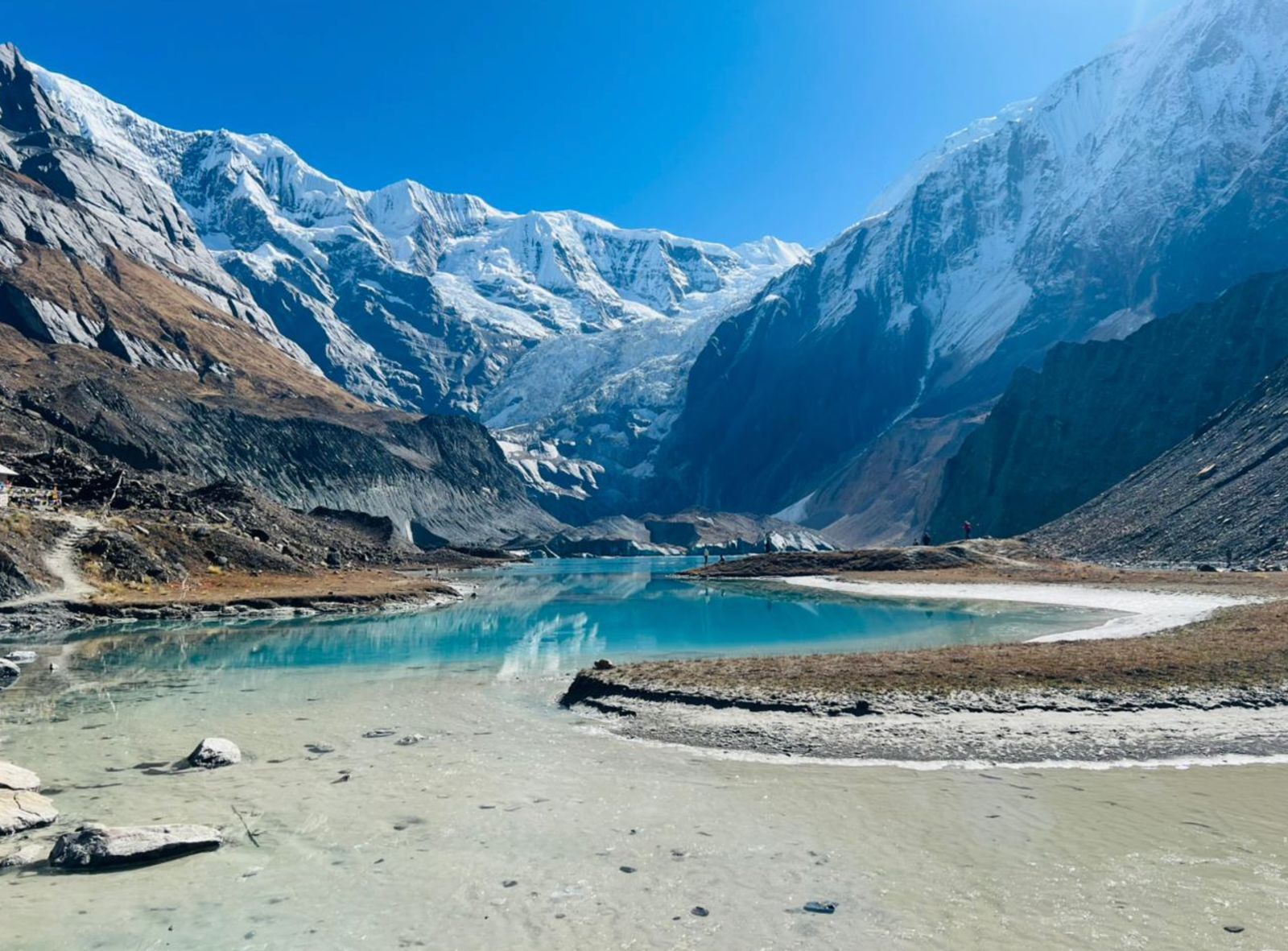
Annapurna North Base Camp Trek
Be among the privileged few to trek the less-traveled Annapurna North...
Everest Base Camp 11 Days Trek
Everest Base Camp Trek 11 days Highlights Thrilling scenic flight to...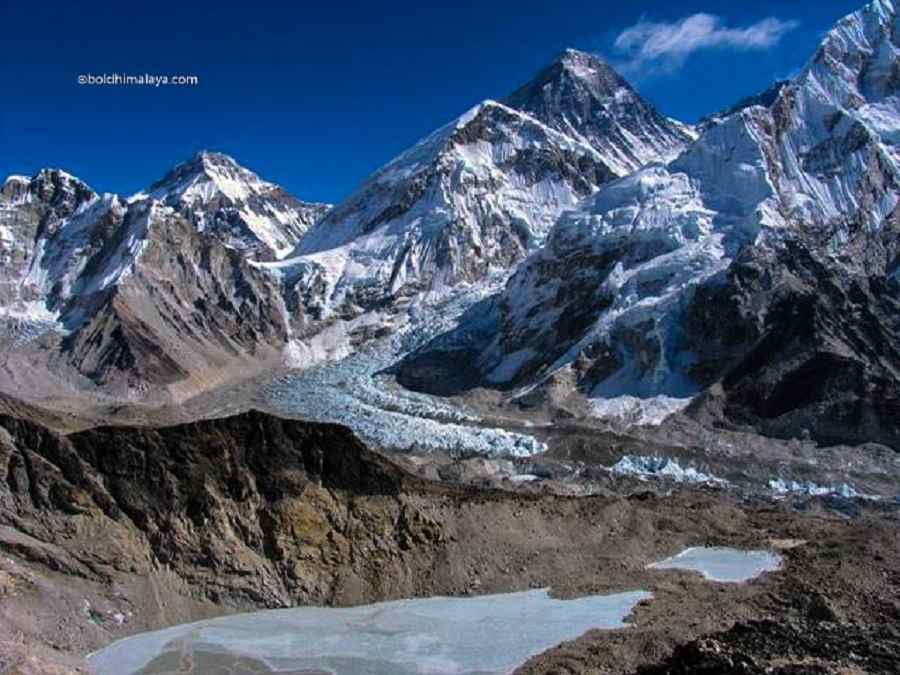
Save 30%
Everest Base Camp Luxury Lodge Trek
The Everest Base Camp Luxury Lodge Trek is one of the...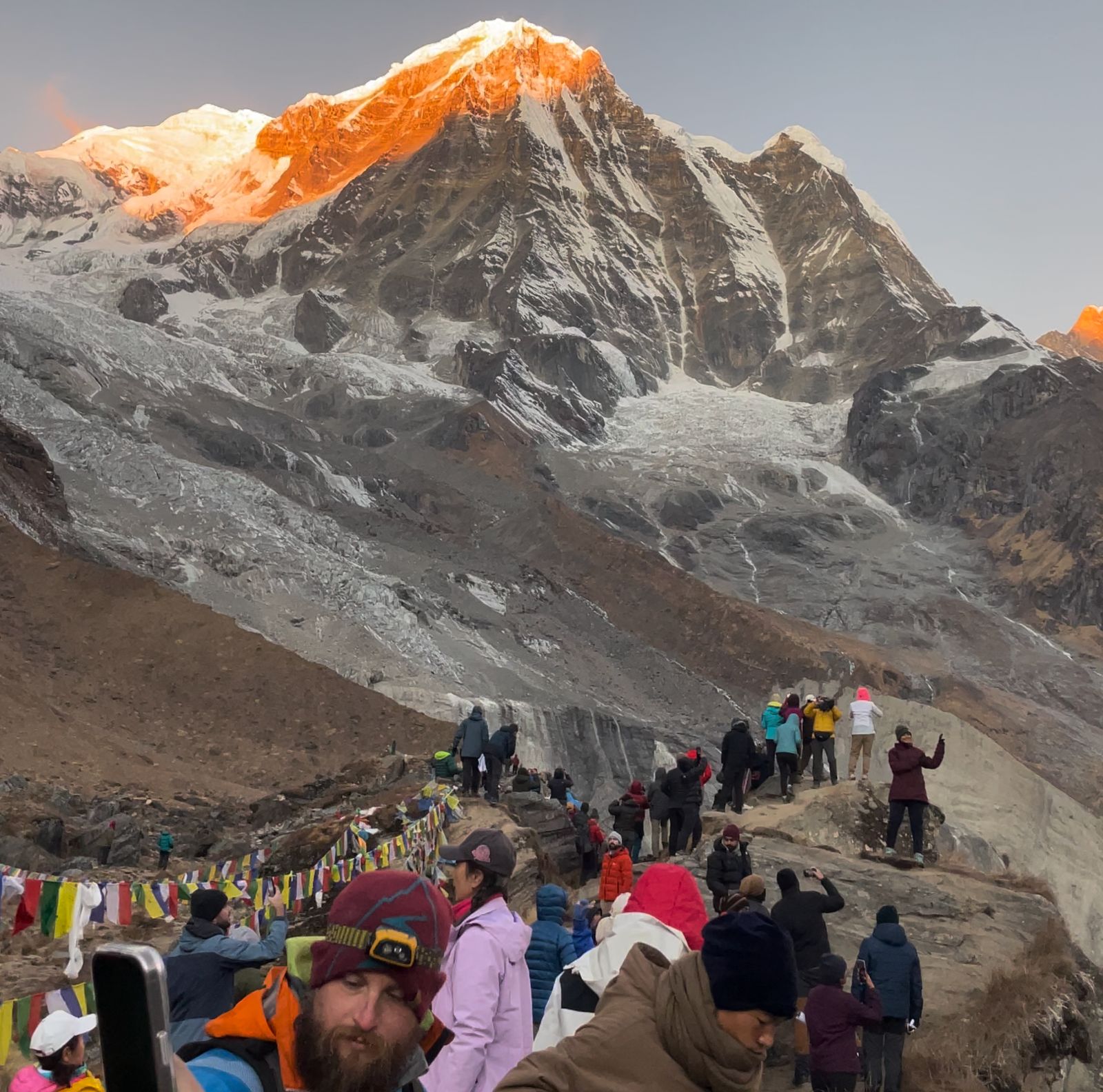
Annapurna Sanctuary Trek
Annapurna Sanctuary Trek is the most breathtaking and easiest high-altitude trek...
Save 32%






